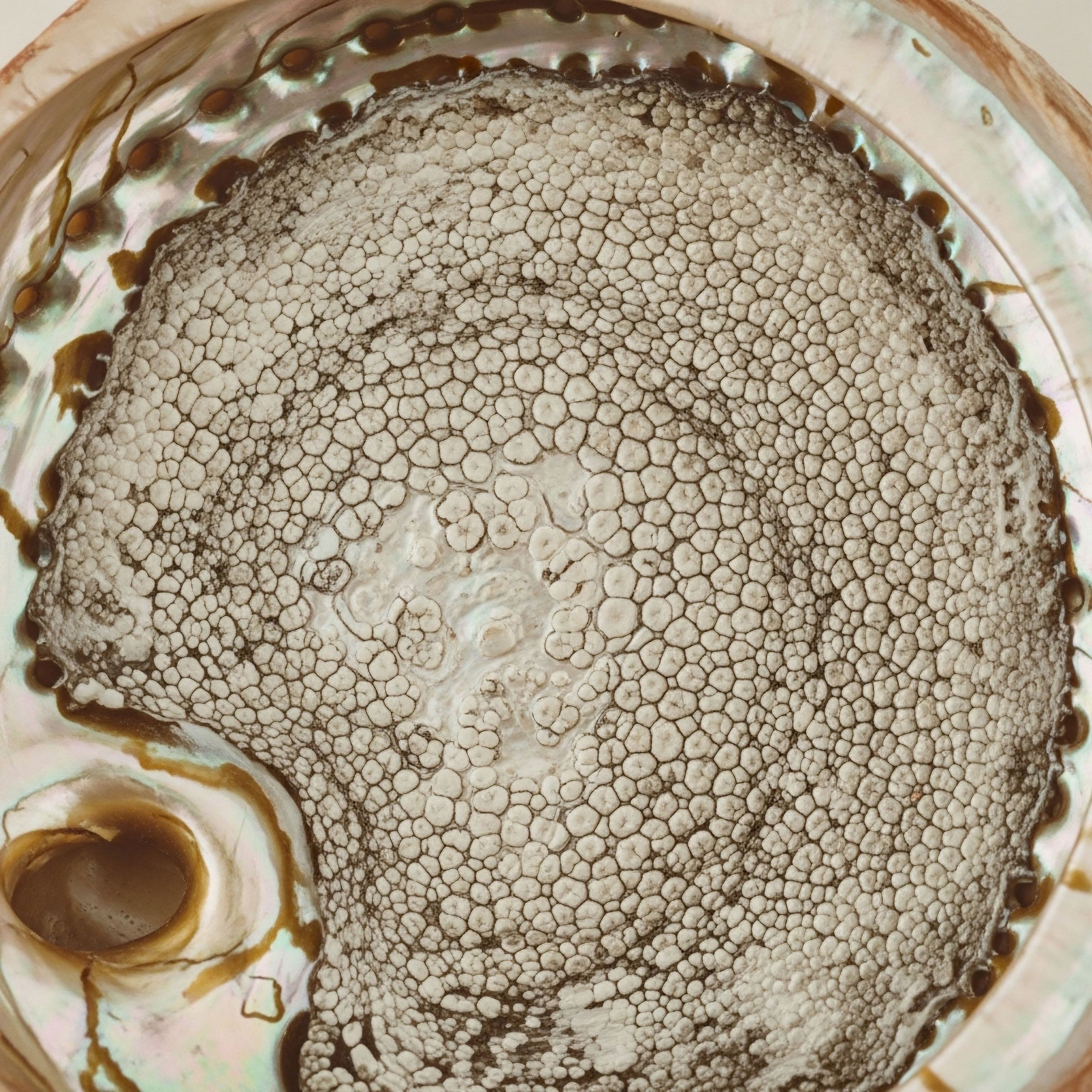

Fundamentals
The decision to use anabolic compounds often originates from a desire for enhanced physical performance and a specific aesthetic outcome. The experience of seeing your body change, grow stronger, and perform at a higher capacity is a powerful motivator.
A secondary effect, one that is frequently less discussed in the beginning, is the profound silence that gradually descends upon your body’s own hormonal communication network. You may have noticed this quietness not as an absence of sound, but as a collection of symptoms ∞ a decline in libido, a shift in mood, a sense of fatigue that sleep does not seem to fix, and the specific, deeply personal concern of diminished fertility.
These are not isolated events. They are signals from a biological system that has been temporarily superseded. Understanding this system is the first step toward reclaiming its function.

The Conductor of Your Endocrine Orchestra
At the very center of male hormonal health is a sophisticated feedback loop known as the Hypothalamic-Pituitary-Gonadal (HPG) axis. This system functions like a finely tuned thermostat, constantly monitoring and adjusting the body’s hormonal environment. The hypothalamus, located in the brain, acts as the command center. It releases Gonadotropin-Releasing Hormone (GnRH) in precise pulses. These pulses signal the pituitary gland, a small but powerful structure at the base of the brain, to release two key messenger hormones:
- Luteinizing Hormone (LH) ∞ This hormone travels through the bloodstream directly to the Leydig cells in the testes, instructing them to produce testosterone.
- Follicle-Stimulating Hormone (FSH) ∞ This second hormone acts on the Sertoli cells within the testes, which are the nurseries for sperm production, or spermatogenesis.
Testosterone produced in the testes serves its many functions throughout the body. It also sends a feedback signal back to the hypothalamus and pituitary, effectively telling them that the job is done and they can ease up on the signaling. This negative feedback loop ensures hormonal balance, preventing both deficiency and excess.
Your body’s natural hormonal rhythm is governed by a precise communication system between the brain and the testes.

How Anabolic Suppression Silences the System
When you introduce exogenous androgens, such as anabolic steroids, into your bloodstream, the HPG axis detects abnormally high levels of testosterone-like compounds. The hypothalamus and pituitary perceive this abundance as a signal that the testes are overproducing. In response, they initiate a protective shutdown.
The release of GnRH from the hypothalamus slows or stops completely. Consequently, the pituitary ceases its output of LH and FSH. Without the stimulating signals from LH and FSH, the testes become dormant. This leads to two primary outcomes:
- A halt in endogenous testosterone production within the testes.
- A cessation of spermatogenesis, leading to infertility.
This state is known as anabolic steroid-induced hypogonadism. The physical manifestation of this can be testicular atrophy, a reduction in testicular size, which is a direct result of the lack of hormonal stimulation. The symptoms you experience are the body’s way of communicating this internal state of dormancy. The goal of clinical restoration protocols is to systematically reawaken this entire communication pathway from the top down.


Intermediate
Reawakening the dormant Hypothalamic-Pituitary-Gonadal (HPG) axis requires a strategic and methodical approach. The process involves using specific pharmacological agents that mimic the body’s natural signaling molecules, effectively reminding the system how to function. Clinical protocols are designed to restart testicular activity and re-establish the brain-to-testes communication network. The choice of protocol and its components depends on the individual’s specific situation, including the duration of suppression and the urgency of fertility restoration.

The Clinical Toolkit for HPG Axis Reactivation
Restoration protocols typically utilize a combination of compounds that act at different points along the HPG axis. These interventions are designed to either directly stimulate the gonads or to encourage the brain to resume its natural signaling functions.

Human Chorionic Gonadotropin (hCG) a Direct Testicular Signal
Human Chorionic Gonadotropin (hCG) is a hormone that is structurally very similar to Luteinizing Hormone (LH). It functions as a powerful LH analogue, binding directly to the LH receptors on the Leydig cells in the testes. This action provides a direct “jump-start” to the dormant testicles, prompting them to resume two critical functions:
- Intratesticular Testosterone Production ∞ hCG stimulates the Leydig cells to produce testosterone inside the testes. This localized production is vital for spermatogenesis, as sperm cells require a much higher concentration of testosterone for maturation than is found in the general bloodstream.
- Support for Spermatogenesis ∞ By raising intratesticular testosterone levels, hCG creates the necessary environment for the Sertoli cells to begin nurturing the development of new sperm.
Protocols often initiate with hCG to get the testes themselves functioning again before addressing the upstream signaling from the brain. It is a foundational step in restoring the machinery of hormone and sperm production at the gonadal level.

Selective Estrogen Receptor Modulators (SERMs) Restoring the Brains Signal
While hCG directly stimulates the testes, Selective Estrogen Receptor Modulators (SERMs) work at the level of the hypothalamus and pituitary gland. In men, a small amount of testosterone is converted into estrogen, which plays a role in the negative feedback loop that suppresses GnRH and LH release.
SERMs block the estrogen receptors in the brain, effectively making the hypothalamus believe that estrogen levels are low. This perceived deficit prompts the hypothalamus to increase its production of GnRH, which in turn stimulates the pituitary to release LH and FSH. The two most common SERMs used in these protocols are:
- Clomiphene Citrate (Clomid) ∞ This is a widely used SERM that has been shown to effectively increase LH, FSH, and endogenous testosterone levels, thereby stimulating both testosterone production and spermatogenesis.
- Tamoxifen Citrate ∞ Possessing a similar mechanism of action to clomiphene, Tamoxifen also serves to block estrogenic feedback in the brain, promoting the release of gonadotropins.
Clinical interventions use specific agents to either directly stimulate the testes or to restart the brain’s own hormone-releasing signals.

Comparing Primary Restoration Agents
The selection and combination of these agents allow for a tailored approach to fertility restoration. The following table outlines the primary characteristics of each compound.
| Agent | Mechanism of Action | Primary Target | Role in Protocol |
|---|---|---|---|
| Human Chorionic Gonadotropin (hCG) | Mimics Luteinizing Hormone (LH) | Leydig cells in the testes | Directly stimulates intratesticular testosterone production and initiates testicular function. |
| Clomiphene Citrate (Clomid) | Blocks estrogen receptors in the hypothalamus | Hypothalamus and Pituitary Gland | Reduces negative feedback, prompting the brain to produce its own LH and FSH. |
| Tamoxifen Citrate | Blocks estrogen receptors in the hypothalamus | Hypothalamus and Pituitary Gland | Similar to Clomiphene, it helps restore the natural pulsatile release of gonadotropins. |

What Does a Typical Recovery Protocol Involve?
A common therapeutic strategy involves a phased approach. It might begin with hCG to re-establish testicular volume and function. After a period of hCG-only therapy, a SERM like Clomiphene or Tamoxifen is often introduced. This combination works on both ends of the axis simultaneously ∞ hCG directly supports the testes, while the SERM encourages the brain to produce its own stimulating hormones.
The goal is to eventually taper off the hCG, allowing the body’s natural, SERM-stimulated LH production to take over completely. Throughout this process, regular blood work and semen analysis are performed to monitor hormone levels and track the return of sperm production. The entire process requires patience, as the full cycle of spermatogenesis takes approximately 74 days, and it may take several cycles for sperm counts to reach fertile levels.


Academic
A sophisticated understanding of fertility restoration following anabolic suppression moves beyond the basic mechanisms of HPG axis stimulants. It requires a deeper analysis of the cellular and temporal dynamics of spermatogenesis, the factors influencing individual response to treatment, and the role of adjunctive therapies in optimizing outcomes.
The clinical challenge is to guide a biological system from a state of profound quiescence back to complex, coordinated function. The timeline for this recovery is highly variable and is influenced by a constellation of factors, making a one-size-fits-all protocol insufficient for complex cases.

What Factors Dictate the Timeline for Spermatogenesis Recovery?
The return of fertility is not a simple switch. It is a biological process contingent on several variables. Research has identified key factors that significantly affect the time to recovery of spermatogenesis. A 2015 study highlighted that both advanced age and an increased duration of testosterone therapy have negative effects on the recovery timeline.
Men who have been suppressed for longer periods may face a more prolonged and challenging path to restoring testicular function. The specific anabolic compounds used also play a role; some substances are more suppressive than others, leading to a deeper and more persistent shutdown of the HPG axis. The assumption that a previously fertile man will quickly return to baseline is not always accurate; one pooled analysis showed that only 67% of eugonadal men recovered spermatogenesis at 6 months post-cessation.

The Critical Role of Follicle-Stimulating Hormone
While hCG and SERMs are effective at restarting LH production and intratesticular testosterone, they may not be sufficient to fully restore robust spermatogenesis in all individuals. Follicle-Stimulating Hormone (FSH) is the other critical gonadotropin, acting directly on the Sertoli cells, which are responsible for nurturing developing sperm through their complex maturation stages.
In cases of prolonged or severe suppression, endogenous FSH recovery can lag behind LH recovery. Without adequate FSH signaling, the “sperm nurseries” of the testes may not function optimally, even if testosterone levels are adequate.
In these situations, the use of recombinant human FSH (rhFSH) can be a powerful adjunctive therapy. Clinical evidence suggests that the addition of FSH to a protocol can decrease the time to recovery of spermatogenesis, particularly in men presenting with azoospermia (the complete absence of sperm in the ejaculate). This approach provides the testes with both of the essential pituitary signals required for full reproductive function.
The successful restoration of fertility often depends on a multi-faceted clinical strategy that addresses both LH and FSH pathways.

Advanced and Novel Therapeutic Strategies
The field of andrology continues to evolve, with ongoing research into more efficient and targeted therapies for restoring fertility. These novel approaches aim to improve outcomes and offer alternatives to traditional protocols.
The following table details some of these advanced strategies, contrasting them with standard treatments.
| Therapeutic Agent | Mechanism of Action | Potential Advantage | Clinical Context |
|---|---|---|---|
| Enclomiphene Citrate | The pure anti-estrogenic isomer of clomiphene citrate, it blocks estrogen feedback without the estrogenic effects of its counterpart isomer (zuclomiphene). | May offer a cleaner and more potent stimulation of the HPG axis with fewer potential side effects compared to standard clomiphene. | Used as an alternative to clomiphene for men seeking to boost endogenous testosterone while maintaining or enhancing fertility. |
| Intranasal Testosterone Gel | A unique, rapid-acting testosterone formulation applied multiple times daily, mimicking the natural pulsatile release of GnRH. | This pulsatile administration may reduce the negative feedback on the HPG axis, potentially preserving spermatogenesis better than long-acting testosterone injections. | An emerging option for men with hypogonadism who wish to maintain fertility during testosterone therapy. |
| Anastrozole | An aromatase inhibitor that blocks the conversion of testosterone to estrogen. | Can be used adjunctively to lower estrogen levels, which may help reduce negative feedback on the HPG axis, especially in men with high aromatase activity. | Used cautiously in restoration protocols, as some estrogen is necessary for healthy sperm function and libido. |
These advanced protocols underscore a systems-biology perspective on fertility restoration. The interplay between LH, FSH, intratesticular testosterone, and estrogen feedback is a delicate balance. A successful clinical outcome hinges on a protocol that is not only potent but also intelligently designed to mimic the body’s natural endocrine rhythms.
For individuals facing the most challenging cases of suppression, options like microdissection testicular sperm extraction (micro-TESE) may be considered to retrieve sperm directly from the testicular tissue for use in assisted reproductive technologies, representing the final frontier when hormonal stimulation protocols are insufficient.

References
- Campbell, Kevin J. et al. “Updated protocols for optimizing sperm recovery after steroid use.” Arch Stem Cell Ther, vol. 2, no. 1, 2021, pp. 8-11.
- Tatem, Alexander J. et al. “Management of Anabolic Steroid-Induced Infertility ∞ Novel Strategies for Fertility Maintenance and Recovery.” Translational Andrology and Urology, vol. 8, no. 2, 2019, pp. 189-197.
- Kohn, Taylor P. et al. “Medical and Surgical Management of Male Infertility.” The Journal of Urology, vol. 196, no. 4, 2016, pp. 1049-1057.
- Liu, P. Y. et al. “The rate, extent, and modifiers of spermatogenic recovery after hormonal contraception in men.” The Lancet, vol. 363, no. 9416, 2004, pp. 1415-1423.
- Ramasamy, Ranjith, et al. “Successful fertility treatment in men with anabolic steroid-induced azoospermia.” Fertility and Sterility, vol. 103, no. 5, 2015, pp. 1205-1208.

Reflection

Charting Your Own Biological Course
The information presented here provides a map of the biological territory and the clinical tools available for navigating it. This knowledge is the foundational element of taking control of your health. The journey back to hormonal balance and restored fertility is a deeply personal one, guided by the unique specifics of your own physiology and history.
Each blood test, each symptom, and each small sign of progress is a data point on your individual chart. Your body has an innate capacity for function and balance. The path forward involves working intelligently with that capacity, using precise protocols as a guide to help your system rediscover its own rhythm.
This process is a collaboration between you, your body, and informed clinical guidance. The ultimate goal is to move from a state of managed recovery to one of sustained, independent vitality.



